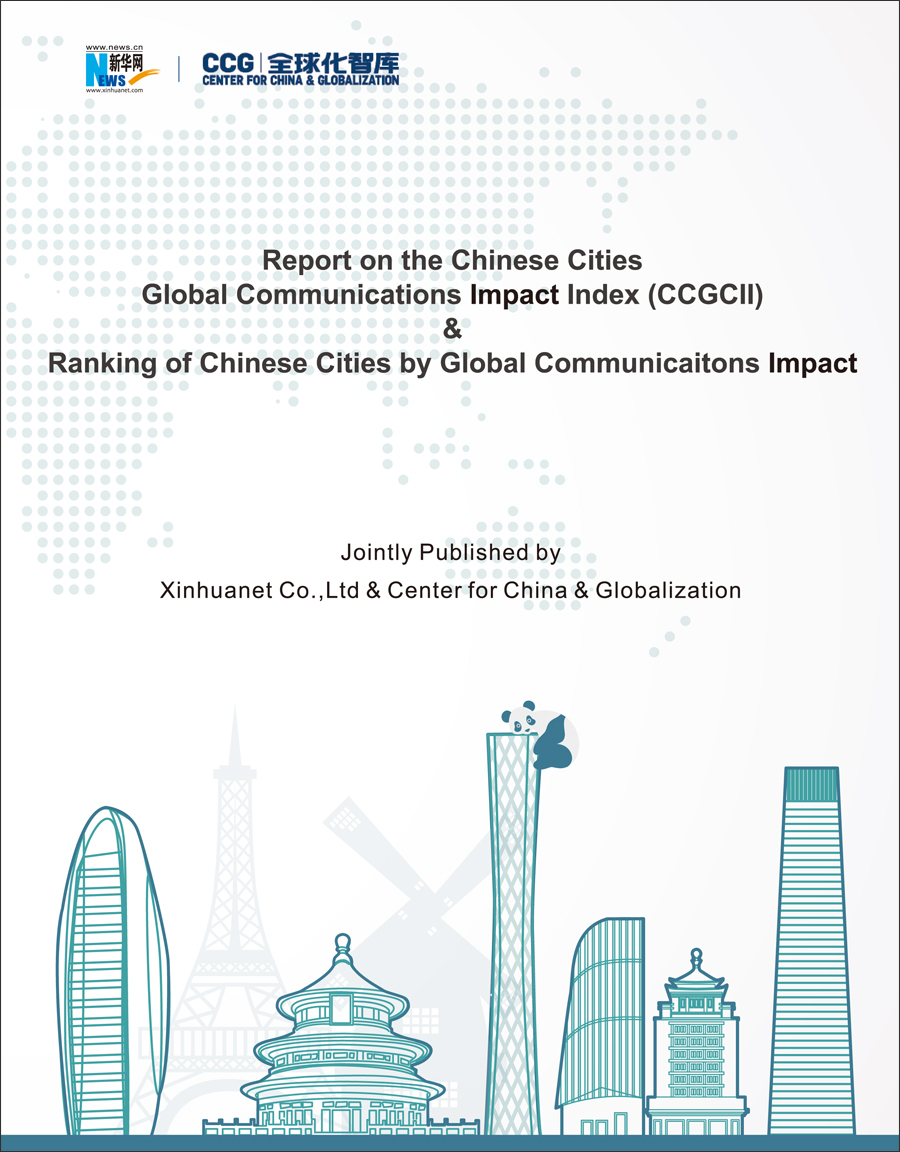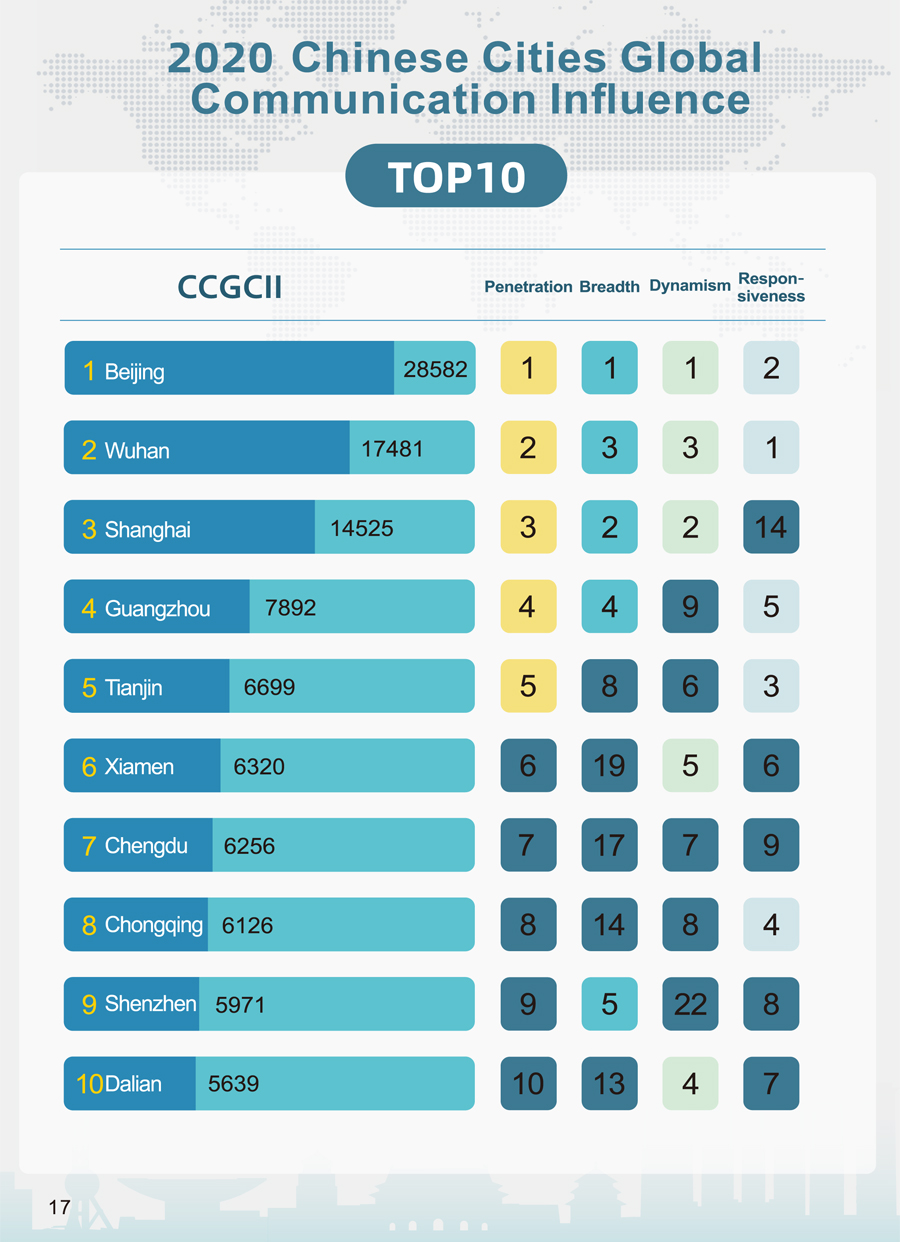CCG and Xinhuanet jointly release report of CCGCII

In recent years, the “go global” strategy has spurred new trends and developments in global communication efforts to cultivate the image of Chinese cities. Given the differences between China and other countries in terms of the communication environment and practices, it is important to systematically study and analyze the global communication impact of Chinese cities in both international mainstream media and social media.
Recently, the Center for China and Globalization (CCG) and Xinhuanet, the most important online portal of China, jointly released a report evaluating Chinese cities’ global communication impact, analyzing the problems concerning these cities’ communication tactics, and offering suggestions on improving their “go global” strategies.
This study covered the top 100 cities in China, as ranked by GDP in 2019, and analyzed the impact of their global communications in 2020. Based on this, researchers compiled the “Chinese City Global Communications Impact Index (CCGCII)” and the “Ranking of Chinese Cities by Global Communications Impact.”
Cities in the diverse sample cover each part of China, such as Beijing, Wuhan, Shanghai, Guangzhou, Tianjin, Xiamen, Chengdu, Chongqing, Shenzhen and Dalian.
The big data used in this study is from the Xinhua RIS data bank, which includes over 10 million pieces of public information from overseas mainstream media and international social media platforms, including various international media outlets and public data from platforms such as Facebook, Twitter, Instagram, and YouTube.

The CCGCII provides an assessment of each city’s global communication impact in terms of communication volume, reputation, coverage, dynamism, and responsiveness.
Key findings are as follows:
1. The total number of pieces of effective information disseminated by China’s top 100 cities exceeded 10 million in 2020, nearly seven times the total in 2019. Of the 10 million pieces, 86.43% were positive or neutral, which is 7.37% higher than in 2019. In 2020, issues related to COVID-19 became hot topics of international public debate. During this period, China’s decisive and effective anti-pandemic efforts and the important role China played in international cooperation to deal with the pandemic were widely recognized by the international community.
2. In 2020, the top 10 Chinese cities in terms of global communications impact were Beijing, Wuhan, Shanghai, Guangzhou, Tianjin, Xiamen, Chengdu, Chongqing, Shenzhen, and Dalian (as ranked by order). These 10 cities account for over 90% of the total communications volume measured.
3. Social media platforms were the primary channels for global engagement. Taken together, Twitter, Facebook, Instagram, and YouTube accounted for more than half of communications (55.28%), exceeding the volume delivered via overseas mainstream media (44.72%). The exposure of Chinese cities was highest on Instagram and Facebook, which are relatively lightweight, convenient, and diversified in terms of information production and dissemination. Videos and live streaming have been adapted to present cities’ unique features.
4. The leading topics for city communications were culture, education, food, healthcare, economy, festivals, industry, and transport.
The study also shows the challenges facing Chinese cities such as, a high proportion of the information disseminated by cities is rather disorganized and the diversity of communications needs to be improved, and the ability of cities to produce innovative content remains relatively weak and there is insufficient integration between Chinese and Western culture.
Meanwhile, the Chinese cities need to improve their ability to dig deeper and develop topics to differentiate themselves, and at present, there is a tendency for the government and official institutions to work alone as the main agents of communication. Furthermore, the Chinese cities have not sufficiently integrated their efforts into the international discourse system or formed an effectively shared semantic space with the global audience.
In terms of those challenges, the study offers valuable suggestions. First, the Chinese cities should fully leverage the guiding role of official accounts and seek to minimize the negative impact of disorganized or fragmented communications. And, it is also suggested that cities pick interesting and unique topics to capture the attention of the audience and create interaction, such as introducing how to make Chinese cuisine. Graphics and videos of high quality are found to be more appealing.
Besides, popular international events and issues can be used as starting points. Rapid responses to these can enhance Chinese cities’ international integration. Cities should also seek ways to bridge cultural gaps, such as comparing the different ways of making food out of flour globally.
Another suggestion is, multiple players, such as opinion makers, media, organizations, individuals and enterprises, should be involved to convey diverse information presenting different aspects of a city.
The study also found that China’s top 100 cities at present still heavily rely on text and images for communication with global audiences. Richer and more diverse ways of presentation need to be developed, such as videos and live streaming, to produce high visual impact and a wide spectrum of expression. Multimedia integration helps amplify the dissemination of information.
Another important suggestion is, Chinese cities should pay attention to the differences in culture, language, and values of different countries. It is also important to grasp users’ consumption habits on different social media platforms to optimize Chinese cities’ communications efforts and enhance their global image.
Alistair Michie, secretary general of British East Asia Council, noted that the rich diversity of China is very little known outside of China. He said that this research report has created an important foundation for further work. He suggested that Chinese cities should establish two-way interaction when communicating with international audiences.
David Blair, an economist and former columnist for China Daily, suggested that China should put more effort into conveying the high quality and dynamism of city life in China.
The report is also received recognition from Evan Due, Senior Fellow at the Institute of Asian Research, School of Public Policy and Global Affairs at the University of British Columbia; Harvey Dozing, Senior Consultant of the National Image Communication Research Center of Tsinghua University; Tatiana Prazeres, former senior advisor to the Director General of the World Trade Organization and Secretary of Foreign Trade of Brazil; Edgar Perez, an international consultant affiliated with the Ponemon Institute, Gerson Lehrman Group and Guidepoint Global Advisors; Laurence Brahm, an international lawyer, political-economist, author and winner of many international film awards; Andy Mok, CGTN commentator on technology and geopolitics; Wenshan Jia, Distinguished Professor of Communication at Shandong University and Dean of Global Engagement Academy Shandong University (Weihai); and Ali Shirvani, Researcher at the Middle East Institute of Northwestern University (Xi’an).
The study aimed to provide cities with a clearer understanding of their own reputation and the characteristics and impact of their global communication efforts, so that they can improve their communications capacities and enhance their global impact.





